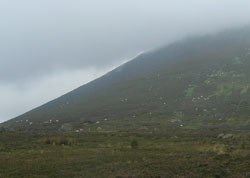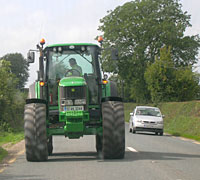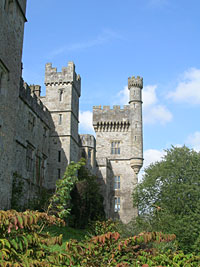Dennis Deery
 Last weekend we decided to head for the town of Lismore and the famous Lismore Castle. We hadn’t gotten very far down the road before I saw a sign for “Mahon Falls” - given my penchant for following interesting signs, it was time for a detour. We live within sight of the Comeragh Mountains, but hadn’t ventured that direction yet. A short drive brought us to the Comeragh Drive, which very shortly had us parked near the top of the mountain overlooking a waterfall, fogged-in mountains, sheep everywhere, and an incredible view of the Mahon Valley. Given the fog we didn’t have much luck with pictures, but we decided the views here would be worth several trips back.
Last weekend we decided to head for the town of Lismore and the famous Lismore Castle. We hadn’t gotten very far down the road before I saw a sign for “Mahon Falls” - given my penchant for following interesting signs, it was time for a detour. We live within sight of the Comeragh Mountains, but hadn’t ventured that direction yet. A short drive brought us to the Comeragh Drive, which very shortly had us parked near the top of the mountain overlooking a waterfall, fogged-in mountains, sheep everywhere, and an incredible view of the Mahon Valley. Given the fog we didn’t have much luck with pictures, but we decided the views here would be worth several trips back.
 So, on to Lismore! Another half-hour down the road brought us up behind a convoy of several tractors holding up traffic. We settled in and toddled along behind them, behind enough cars that we couldn’t really see the tractors. After a few miles some of the tractors and their escort truck pulled over and stopped, allowing us to get around them. Once we did, we quickly caught up to one of the tractors still driving down the road. Now, it’s a little hard to tell from a still photo. But look closely - see anything a little off there? That’s a farmer driving his tractor down a major highway in reverse - in fact, he’s one of 6 farmers doing that. Fortunately we had seen on the television news the night before that a farmer’s group was doing a long drive across the Irish countryside in reverse as a fundraiser. We hadn’t paid close enough attention to remember what they were raising funds for, but it was quite a sight!
So, on to Lismore! Another half-hour down the road brought us up behind a convoy of several tractors holding up traffic. We settled in and toddled along behind them, behind enough cars that we couldn’t really see the tractors. After a few miles some of the tractors and their escort truck pulled over and stopped, allowing us to get around them. Once we did, we quickly caught up to one of the tractors still driving down the road. Now, it’s a little hard to tell from a still photo. But look closely - see anything a little off there? That’s a farmer driving his tractor down a major highway in reverse - in fact, he’s one of 6 farmers doing that. Fortunately we had seen on the television news the night before that a farmer’s group was doing a long drive across the Irish countryside in reverse as a fundraiser. We hadn’t paid close enough attention to remember what they were raising funds for, but it was quite a sight!
 Finally we reached the little town of Lismore. We had left home knowing only that Lismore was fairly close, and that there was a castle there - we figured Lismore Castle couldn’t be too hard to find once we got to the area. We were certainly right about that. The castle sits right at the entrance to town as you cross the Blackwater River. The Blackwater, known in Ireland for it’s salmon fishing, was lined with fly fishermen. The castle is really quite an impressive sight as you cross the bridge into town, almost a fairy-tale castle as Kathleen said.
Finally we reached the little town of Lismore. We had left home knowing only that Lismore was fairly close, and that there was a castle there - we figured Lismore Castle couldn’t be too hard to find once we got to the area. We were certainly right about that. The castle sits right at the entrance to town as you cross the Blackwater River. The Blackwater, known in Ireland for it’s salmon fishing, was lined with fly fishermen. The castle is really quite an impressive sight as you cross the bridge into town, almost a fairy-tale castle as Kathleen said.
We spent a good share of the afternoon touring the castle gardens and the town of Lismore. The castle is still used by the owners, so we couldn’t take a tour of that - though if you come to visit, it is rentable by visitors
The town of Lismore was founded in 636 A.D., and has been inhabited ever since. The castle was first built in 1185 A.D. The castle has been owned by the family since the late-1700’s, and the building standing today was mostly built in the mid-1800’s. The castle was once owned by Sir Walter Raleigh, along with 42,000 acres of land. Robert Boyle, chemist and physicist extraordinaire, inventor of Boyle’s Law (before you click that link, can you remember it from high school chemistry?), was born in the castle. In more recent times, Fred Astaire’s sister lived there as the wife of Lord Cavendish from 1932-1944. When Lord Cavendish was killed in WWII, Adele returned to the United States. John F. Kennedy, on his 1963 visit to Ireland, stayed in Lismore Castle. (The Kennedy visit is something that keeps popping up, as the Irish are incredibly proud of Kennedy’s heritage and fondly recall his visit here.)
 Late in the afternoon we headed for home, and once again got sidetracked by a sign, this one pointing to the Dromana Gate, which we had learned about at the Lismore Heritage Center. This gate, really out in the middle of nowhere, stands over a bridge crossing the Finisk River. It was built in 1851 in papier mache to mark the wedding of a local businessman. When he and his wife returned they were so impressed with it that they then permanently reconstructed it. Click here for a great 360-degree panorama photo of the gate. So with that little drama, our Saturday drive ended.
Late in the afternoon we headed for home, and once again got sidetracked by a sign, this one pointing to the Dromana Gate, which we had learned about at the Lismore Heritage Center. This gate, really out in the middle of nowhere, stands over a bridge crossing the Finisk River. It was built in 1851 in papier mache to mark the wedding of a local businessman. When he and his wife returned they were so impressed with it that they then permanently reconstructed it. Click here for a great 360-degree panorama photo of the gate. So with that little drama, our Saturday drive ended.
Sunday morning we took a brief trip to Dunmore East, a small fishing village about 6 miles up the coast from here. You can see more pics from the entire weekend below. Note that thatched roofs in Dunmore East. That type of roof is really quite common here, and is actually still being used in new construction.

























